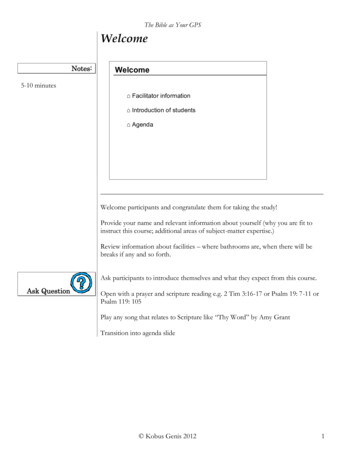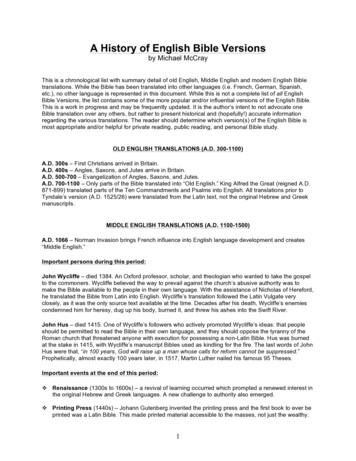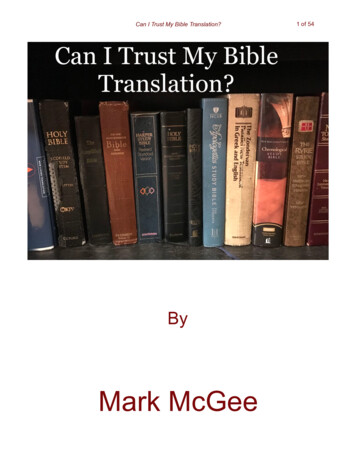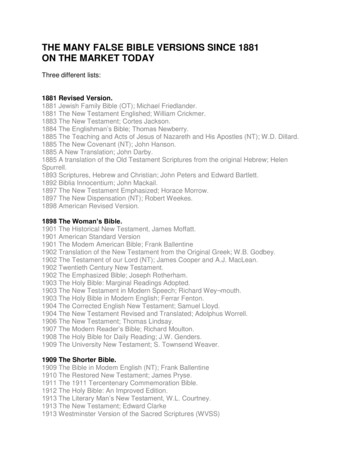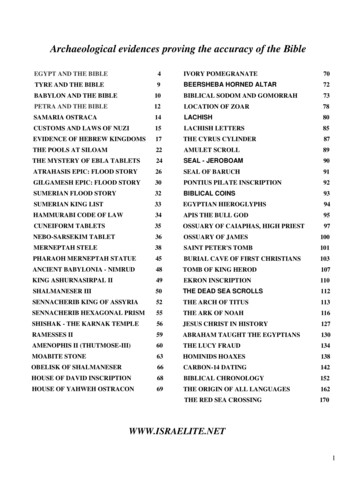
Transcription
How to Read the BibleNew Testament LettersVIDEO NOTESIn the New Testament, there are 21 letters written by early Christian leaders to communities ofJesus’ followers in the ancient Roman world. A wise reading of these letters involves learningabout their historical and literary context. That’s what our two videos on How to Read the NewTestament Letters are all about!In these video notes, we’ll explore in depth the different layers of historical and literary contextwithin these letters, so that we can better understand the wisdom they still have to offer.
ContentsIntroduction 3The Modern Inclination to Overlook Context 4Skill 1: Read Letters as a Whole 24Problematic Passages for Direct Application 5Skill 2: Mirror Reading 2665 Things to Pay Attention To inMirror Reading 27A Way Forward: Reading the NewTestament Letters in Context 1. The Narrative Context 62. The Cultural Context 63. The Situational Context 74. The Literary Context 7The Narrative Context 7Theme 1: The Image of God 7Theme 2: The Family of AbrahamBringing Blessing to the Nations 8Theme 3: The Messianic Servant 10The Situational Context Applying Narrative, Cultural, andSituational Context to Romans 2427Phoebe: Letter Bearer 29House Churches 30Ethnic Diversity 30Divisions and Schism 30Powerful and Non-Powerful 31Gift to Jerusalem 32Ruling Authorities 33Summary 33Jesus: True Human Image, MessianicServant Over the Nations 10The Literary Context The Apostles Continue the Story 12The Logistics of First Century Letter Writing 34The Cultural Context 14The Form of First Century Letters The Roman Empire 15Honor and Shame in the Greco-Roman World 15Implications of the Greco-RomanStandards for Honor 16Multicultural Dynamics of Honor and Shame 17Honor and Shame in the New Testament 173437Overview 37Part 1: The Opening 38Part 2: Thanksgiving 41Part 3: Body of the Letter 43Part 4: The Closing 4518Steps for Tracing the Main Idea andRhetorical Flow of a New Testament letter 48Patriarchy and Family Structure 19Step 1: Isolate the Main Paragraphs 48Notes on Slavery 20Patriarchy in the New Testament Letters 20Step 2: Study the Main Ideas/Pointsof the Opening Paragraph 48Patronage and Honor 22Step 3: Identify the Main Ideasand Rhetorical Goal of Paragraph 49Step 4: Identify the RelationshipsBetween Paragraphs 53Hierarchy and Patriarchy Sources Most scripture quotations are from the New American Standard Bible (NASB). Some scripture quotations have theHebrew or Greek translation replace certain words or phrases. Emphasis added.56
IntroductionThe New Testament has a large collection of ancient letters from the circle of the apostles: Paul: 13 letters to 7 church communities Peter: 1 & 2 Peter John: 1, 2, 3, John Jacob (“James”) Jude To the HebrewsThe letters from the apostles found in the Bible were not written as timeless, abstract essayson theology and ethics. They are real letters with real audiences, written for particular purposesand in response to specific situations. For a robust understanding of these texts, and to makesure that we don’t take their words out of context, we need to develop a reading skill-set thattakes all this into consideration.So how do we essentially read someone else’s mail? It requires knowledge of the sender, receiver, the situational context of the relationship, and the cultural and language context inwhich these people live. Without considering these factors, we are bound to misunderstandthe meaning of the writers and take their words out of context.How to Read the Bible: New Testament Letters3
The Modern Inclination to Overlook ContextThe special attention needed to read the letters is hard for modern Bible readers to rememberfor lots of reasons. Here are just a few: The rest of the Bible feels challenging to read, and theNew Testament letters can appear “easier” to read incomparison to the Old Testament prophets or laws. The letters are written from an “I” to a “you” audience,which feels immediately relevant to the reader. Thismakes the letters feel like “God’s word to me” in a waythat other parts of the Bible don’t. The New Testament letters are about Jesus, who he is,why he matters, and how I should live as his follower.That seems to directly address me and my place inthe biblical storyline. So, we often assume that we cansimply pick the New Testament letters and plop theminto the life of a local 21st century church where theycan speak to us “directly”. There are lots of “sound-byte” and “tweetable” Christian truths that seem to require no knowledge of context. Here’s a few examples:For the wages of sin is death, but the free gift of God is eternal life inChrist Jesus our Lord.ROMANS 6:23For by grace you have been saved through faith; and that not ofyourselves, it is the gift of God; not as a result of works, so that no onemay boast.EPHESIAN 2:8-9Dear friends, let us love one another, for love comes from God. Everyonewho loves has been born of God and knows God.1 J O H N 4 :7How to Read the Bible: New Testament Letters4
Problematic Passages for Direct ApplicationSome Christians may carry the sentiment “The Bible says it, I believe it, that settles it.” But, thereare many passages that become immediately problematic for those who read the New Testament letters as “God’s word directly to me.” Here’s just a few examples:SCRIPTUREQUESTIONS RAISEDStop drinking only water, and use a little wine because of your stomach andIs wine the cure for stomach illnesses?your frequent illnesses. (1 T I M O T H Y 5 : 2 3 )Greet one another with a kiss of love. (1 P E T E R 5 : 1 4 )Should we be kissing one another to have a propergreeting?Greek one another with a holy kiss. (R O M A N S 1 6 : 1 6 )From now on those who have wives should live as if they have none (1 C O R I N T H I A N S 7 : 2 9 )Does not the very nature of things teach you that if a man has long hair, it isa disgrace to him (1 C O R I N T H I A N S 1 1 : 1 4 )Women should remain silent in the churches.They are not allowed to speak, but must be in submission, as the law says .(1 C O R I N T H I A N S 1 4 : 3 4 )But every woman who prays or prophesies with her head uncovereddishonors her head—it is the same as having her head shaved.What about Genesis 2:23-24 where God blessesmarriage as a sacred gift, or other passages wherePaul affirms or praises marriage (like Ephesians 5)?What about the Nazarites in Numbers 6? There Godcommands men to never cut their hair because itrepresents a sacred dedication to God, like Samson.And what about the fact that we’re told in Acts 18:18that Paul had grown out his hair in a Nazirite vow!What about where Paul clearly assumes andapproves of women leading a house church inpraying and prophesying? And what about Priscilla,who was clearly a teacher in the churches of Corinthand Rome. And what about the women “speaking” inchurch in 1 Corinthians 11?(1 C O R I N T H I A N S 1 1 : 5 )Slaves, obey your earthly masters in everything; and do it, not only whentheir eye is on you and to curry their favor, but with sincerity of heart andreverence for the Lord. (C O L O S S I A N S 3 : 2 2 )What about Galatians 3:28 and Philemon (who livesin Colosee!) where Paul says that slave and free aremeaningless categories in Christ and that Christiansare to recognize that slaves are actually siblings, nottheir slaves?Some Christian traditions have adopted the “pick and choose” method when it comes to “applying” the Bible, especially the epistles. And this raises the question.“How is a letter which Paul directed to specific churches in specific situations atparticular times the word of God for the church at large in all times?”K R I S T E R S T E N DA H L , PAU L A M O N G T H E J E W S A N D G E N T I L E S ,(PHIL ADELPHIA:FORTRESS, 1963): 6.How to Read the Bible: New Testament Letters5
The New Testament was “not written in the first instance for residents of theUnited States at the end of the twentieth century. When we read Paul’s letters tohis churches, we are reading the mail of people who have been dead for nineteen hundred years Only historical ignorance or cultural chauvinism could leadus to suppose that no interpretive ‘translation’ is necessary for us to understandthese texts But if the New Testament’s teachings are so integrally embedded inthe social and symbolic world of the first-century, how do they speak.to us orfor us?”R I C H A R D B . H A Y S , T H E M O R A L V I S I O N O F T H E N E W T E S TA M E N T: A C O N T E M P O R A R YI N T R O D U C T I O N T O N E W T E S TA M E N T E T H I C S ( H A R P E R : S A N F R A N C I S C O , 1 9 9 6 ) , 6 .“Fundamentalists, charismatics, social activists, feminists, evangelicals, traditionalists, liberationists—all of us, in fact—go to the texts of the Bible and returnwith trophies that are replicas of our own theological image. It is no easy taskgenuinely to listen to the voice of Scripture rather than merely to hear the soundof our own echoes.”THOMAS G. LON G, PRE AC HIN G AN D TH E LITER ARYFORMS OF THE BIBLE (PHIL ADELPHIA: FORTRESS, 1989): 28A Way Forward: Reading the New Testament Letters in ContextReading the New Testament letters requires sensitivity to a number of contexts. We’re going tofocus on four:1. The Narrative ContextWhere do the New Testament letters fit within the narrative context of the larger biblical story?Can a better understanding of that context help us in ‘translating’ their message into our ownday?2. The Cultural ContextThe letters were written within a diverse cultural context of the cities to which they were addressed. In particular, we should pay attention to: Jewish Culture: The early messianic Jesus movement was Jewish in culture and language but expanded into the non-Jewish world: James, John, Peter, andPaul all represent unique cultural expressions of earlyChristianity. Greco-Roman Culture: The larger Greco-Roman culture which operated according to the values of honorand shame, hierarchy and patriarchy, patronage andstatus, purity and pollutionHow to Read the Bible: New Testament Letters6
3. The Situational ContextWhat is the relationship of the author and audience? The situational context of the housechurch(es) that provides the backstory of the letter’s occasion, purpose, and motivation whichtherefore informs the interpretation of the letter’s content.4. The Literary ContextThe literary context of the entire letter as a unified act of ancient epistolary communication.The letters must be read in light of the conventions and realities of ancient letter writing, andevery single part of a letter must be understood in light of its function within the developingargument.The Narrative ContextWithin the storyline of the Hebrew Bible, three important themes are developed that set thecontext for the international spread of the Jesus movement and the movement of the letters.1. The Image of God2. The Family of Abraham3. The MessiahTheme 1: The Image of GodIn Genesis 1, God appoints humanity as the divine image who will rule the world in partnership.Then God said,“Let Us make human in Our image,according to Our likeness;and let them rule over the fish of the seaand over the birds of the skyand over the cattleand over all the earth,and over every creeping thing that creeps on the earth.”And God created human in His own image,in the image of God He created him;male and female He created them.G EN ES I S 1: 26 -2 7In Genesis 3, humanity fails at this task and is exiled from the royal-temple-garden. This createsthe need for a new human, a true image of God who can rule as God’s partner over all creation.How to Read the Bible: New Testament Letters7
Theme 2: The Family of Abraham Bringing Blessing to the NationsThe story continues as we follow the life of Abraham and the nation of Israel. God promises tobless the family of Abraham and, through them, bless all nations.ABB’A’Now the Lord said to Abram:Go forth from your country,and from your relativesand from your father’s house,to the land which I will show you;B’and I will make you a great nation,and I will bless you,and make your name great;and so you shall be a blessing;Band I will bless those who bless you,and the one who curses you I will curse.and in you all the families of the earth will be blessed.”ABA’AA’G E N E S I S 1 2:1 - 3Now when Abram was ninety-nine years old, the Lord appeared to Abramand said to him,“I am God Almighty (El Shaddai);Walk before Me, and be blameless.I will establish My covenant between Me and you,And I will multiply you exceedingly.”Abram fell on his face, and God talked with him, saying,“As for Me, behold, My covenant is with you,And you will be the father of a multitude of nations.No longer shall your name be called Abram,But your name shall be Abraham;For I will make you the father of a multitude of nations.“I have made you exceedingly fruitful, and I will make nations of you,G E N E S I S 1 7:1 - 6The blessing of Abraham spread to all nations through a "kingdom of priests". This is best represented by the exalted "messianic servant" who sends out his "servants" to announce the reignof God.‘You yourselves have seen what I did to the Egyptians,and how I bore you on eagles’ wings,and brought you to Myself.And now,if you will listen-listen to my voice and keep My covenant,then you shall be My own special possession among all the peoples,for all the land is Mine,so you shall be to Me a kingdom of priests and a holy nation.’E XODUS 19:4- 6How to Read the Bible: New Testament Letters8
Fast forward to when Israel becomes a nation. God says that through the line of King David, anew human will come who will assume the role as the true image of God.“When your days are fulfilled that you must go to be with your fathers, that I will raiseup one of your seed after you, who will be of your sons; and I will establish hiskingdom. “He shall build for Me a house, and I will establish his throne forever.“I will be his father and he shall be My son; and I will not take My lovingkindnessaway from him, as I took it from him who was before you. “But I will settle him in Myhouse and in My kingdom forever, and his throne shall be established forever.’”2 S A M U E L 7, 1 C H R O N I C L E S 1 7 : 1 1 - 1 4Israel’s prophets speak to this promise. Here are several passages from Isaiah, looking forwardto this new human impacting the nations.Then in that dayThe nations will resort to the root of Jesse,Who will stand as a signal for the peoples;And His resting place will be glorious.I SA I A H 11:1 0He says, “It is too small a thing that You should be My ServantTo raise up the tribes of Jacoband to restore the preserved ones of Israel;I will also make You a light of the nationsSo that My salvation may reach to the end of the earth.”Thus says the Lord, the Redeemer of Israel and its Holy One,To the despised One,To the One abhorred by the nation,To the Servant of rulers,“Kings will see and arise,Princes will also bow down,Because of the Lord who is faithful,the Holy One of Israel who has chosen You.”I S A I A H 4 9 : 6 -7“And, because of what they have planned and done, I amabout to come and gather the people of all nations andlanguages, and they will come and see my glory. I will seta sign among them, and I will send some of the remnantto the nations—to Tarshish, to the Libyans and Lydians. toTubal and Greece, and to the distant islands that have notheard of my fame or seen my glory. They will proclaim myglory among the nations. And they will bring all yourpeople, from all the nations, to my holy mountain inJerusalem as an offering to the Lord—on horses, in chariotsand wagons, and on mules and camels,” says the Lord. “Theywill bring them, as the Israelites bring their grain offerings, tothe temple of the Lordin ceremonially clean vessels. And Iwill select some of them also to be priests and Levites,”says the Lord. “As the new heavens and the new earth that Imake will endure before me,” declares the Lord, “so will yourname and descendants endure.I SA I A H 6 6 :1 8 -2 2How to Read the Bible: New Testament Letters9
Theme 3: The Messianic ServantThrough this Messianic Servant the people become the new covenant Israel. The people of thenew covenant are marked by hearts transformed by God’s new-creation Spirit so that they canlove God and neighbor. Deuteronomy 30:1-6: Circumcision of the heart Jeremiah 31:31-34: Torah written on the heart, everyone knows Yahweh Ezekiel 36:22-30: Yahweh’s Spirit creates new humans who love and listen to GodJesus: True Human Image, Messianic Servant Over the NationsWhen we arrive at the Gospels, the three themes emerging from the Hebrew Scripture converge in the life of Jesus. Jesus presented himself as the royal-priestly servant who is inaugurating the Kingdom of God and creating the New Covenant Israel spoken of in the Torah andProphets. The following verses show the intentional connections to the previous story, and howJesus and his followers continue the plotline.After John was put in prison, Jesus went into Galilee, proclaiming the good news of God.“The time has come,” he said. “The kingdom of God has come near. Turn around and trustthe good news!”M A R K 1:14 -1 5The high priest said to him, “I charge you under oath by the living God: Tell us if you are theMessiah, the Son of God.”“You have said so,” Jesus replied. “But I say to all of you: From now on you will see the Son ofMan sitting at the right hand of the Mighty One and coming on the clouds of heaven.”M AT T H E W 2 6 : 6 3 - 6 4For even the Son of Man did not come to be served, but to be a servant, and to give hislife as a ransom for many.”MARK 10:45In the same way, after the supper he took the cup, saying, “This cup is the new covenant inmy blood, which is poured out for you.L U K E 2 2 : 2 0 , S E E A L S O M AT T H E W 2 6 : 2 6 - 2 8How to Read the Bible: New Testament Letters10
Jesus deputized his disciples as “apostles” who would represent him to Israel and the nations.The word “Apostle” Greek ἀπόστολος / Aramaic “ ׁשָליח one who is sent as a representative”.TO I S R A E L F I R S T. . .T H E N T O T H E N AT I O N S . . .Jesus summoned His twelve disciples and gave them authorityover unclean spirits, to cast them out, and to heal every kind ofdisease and every kind of sickness These twelve Jesus sentout after instructing them: “Do not go in the way of thenations, and do not enter any city of the Samaritans; butrather go to the lost sheep of the house of Israel. “And asyou go, preach, saying, ‘The kingdom of heaven is at hand.’Anyone who welcomes you [apostles] welcomes me, andanyone who welcomes me welcomes the one who sent me.Then Jesus came to them and said, “All authority in heavenand on earth has been given to me. Therefore go andmake disciples of all nations, baptizing them in the name ofthe Father and of the Son and of the Holy Spirit, and teachingthem to obey everything I have commanded you. Andsurely I am with you always, to the very end of the age.”M AT T H E W 1 0 : 1 , 5 -7, 4 0M AT T H E W 2 8 : 1 8 - 2 0Then he opened their minds so they could understand theScriptures. He told them, “This is what is written: The Messiahwill suffer and rise from the dead on the third day, andrepentance for the forgiveness of sins will be preached inhis name to all nations, beginning at Jerusalem. You arewitnesses of these things. I am going to send you what myFather has promised; but stay in the city until you have beenclothed with power from on high.”LUKE 24:45-49In John’s Gospel, Jesus promises the Spirit so that the apostles can continue his own missionin the world.The Advocate, the Holy Spirit, whom the Father will send in my name, will teachyou all things and will remind you of everything I have said to you.JOHN 14:26[‘you all’ the apostles in reference to their role as authorized tradents ofJesus’ message]But when he, the Spirit of truth, comes, he will guide you into all the truth. Hewill not speak on his own; he will speak only what he hears, and he will tell youwhat is yet to come. He will glorify me because it is from me that he will receivewhat he will make known to you.J O H N 1 6 :1 3 -14Again Jesus said, “Peace be with you! As the Father has sent me, I am sendingyou.” And with that he breathed on them and said, “Receive the Holy Spirit.J O H N 20 : 2 1-2 2How to Read the Bible: New Testament Letters11
The Apostles Continue the StoryLet’s look at the summary of the biblical story up to this point: Creation and Image of God Rebellion, the fallout, and Babylon God’s mission through Israel Israel’s exile and the hope for God’s kingdom Jesus: the true royal-priestly image and the Kingdomfor Israel Jesus’ kingdom for the nations through the apostles Consummation of the kingdom in new creationThe apostles play a crucial role in the unified story of the Bible. They traveled around the ancientmediterranean world in the early decades of the Jesus movement (mid-30s and 40s A.D.), announcing that Jesus was the exalted king of the cosmos, calling all nations to believing loyalty.But you will receive power when the Holy Spirit comes on you; and you will be mywitnesses in Jerusalem, and in all Judea and Samaria, and to the ends of the earth.”And after He had said these things, He was lifted up while they were looking on, and acloud received Him out of their sight.They just experienced a vision ofDaniel 7: The crucified and risenone being exalted to the high placeof cosmic rule over the nations.ACTS 1:8-9Paul, a bond-servant of Christ Jesus, called as an apostle,set apart for the gospel of God,which He promised beforehand through His prophets in the holy Scriptures,concerning His Son,who was born of a descendant of Davidaccording to the flesh,who was declared to be the Son of God with power by the resurrection from the dead,according to the Spirit of holiness,Jesus Christ our Lord,through whom we have received graceand apostleship to bring about the believing loyaltyamong all the nations for His name’s sake,among whom you also are the called of Jesus ChristSee also Romans 15:14-33 and the“offering of the nations” to GodR O M A N S 1:1 - 6And what is the surpassing greatness of His power toward us who believe. These are inaccordance with the working of the strength of His might which He brought about inChrist, when He raised Him from the dead and seated Him at His right hand in theheavenly places,far above all rule and authority and power and dominion, and everyname that is named, not only in this age but also in the one to come.E P H E S I A N S 1:1 9 -2 1How to Read the Bible: New Testament Letters12
Let us fix our eyes on Jesus, the pioneer and perfecter of faith. For the joy set before himhe endured the cross, scorning its shame, and sat down at the right hand of thethrone of God.HEBREWS 12:2You are saved “by the resurrection of Jesus Christ, who has gone into heaven and is atGod’s right hand—with angels, authorities and powers in submission to him.”1 PE T ER 3: 2 1B -2 2Now when they had traveled through Amphipolis and Apollonia, [Paul and Silas] came toThessalonica, where there was a synagogue of the Jews. And according to Paul’scustom, he went to them, and for three Sabbaths reasoned with them from theScriptures, explaining and giving evidence that the Messiah had to suffer and rise againfrom the dead, and saying, “This Jesus whom I am proclaiming to you is the Messiah.”And some of them were persuaded and joined Paul and Silas, along with a large numberof the God-fearing Greeks and a number of the leading women.But some Jewish men, filled with zeal, and taking along some wicked men from themarketplace, formed a mob and set the city in an uproar; and attacking the house ofJason, they were seeking to bring them out to the people. When they did not find them,they began dragging Jason and some brethren before the city authorities, shouting,“These men who have turned the world order upside-down have come here also; andJason has welcomed them, and they all act contrary to the decrees of Caesar, sayingthat there is another king, Jesus.”A C T S 1 7 : 1 -7As the apostles traveled around announcing that Jesus is the real king of the world, their oralteachings eventually took shape as writings, and they were viewed as an expression of Jesus’authority over his New Covenant people, alongside the Scriptures of Israel.And we also thank God continually because, when you received the word of God,which you heard from us, you accepted it not as a human word, but as it actuallyis, a word of God, which is indeed at work in you who believe.1 T H E S SA LO N I A N S 2:1 3I charge you before the Lord to have this letter read to all the brothers and sisters.1 TH ESSALONIAN S 5:27So then, brothers and sisters, stand firm and hold fast to the teachings we passedon to you, whether by our spoken word or by letter.2 T H E S SA LO N I A N S 2:1 5How to Read the Bible: New Testament Letters13
I want you to recall the words spoken in the past by the holy prophets and thecommand given by our Lord and Savior through your apostles Bear in mind thatour Lord's patience means salvation, just as our dear brother Paul also wrote youwith the wisdom that God gave him. He writes the same way in all his letters,speaking in them of these matters. His letters contain some things that are hard tounderstand, which ignorant and unstable people distort, as they do the otherScriptures, to their own destruction.2 PE TER 3: 2, 15 -16These teachings involved a call to live as the new covenant family of Abraham, new kinds ofhumans, who embody the ethical vision of Jesus’ kingdom.When you heard about Christ and were taught in him inaccordance with the truth that is in Jesus. You weretaught, with regard to your former way of life,to put off your old humanity,which is being corrupted by its deceitful desiresand that you be renewed in the spirit of your mind,and put on the new humanity,which in the likeness of God has been created inrighteousness and holiness of the truth.EPH ES IAN S 4: 2 1-24The Bottom Line:The apostles’ letters represent the announcement and teaching of king Jesus given to specificlocal house-churches living in the Greek and Roman worlds.We inhabit the same spot in the biblical story as the original recipients, but we live in a vastlydifferent cultural setting. This means we must provide cross-cultural translation of the apostles’teaching into our own multi-cultural contexts.The Cultural ContextThe Jesus movement moved from Jerusalem out into the world first as a messianic Jewishmovement through networks of diaspora synagogues, and then into the wider non-Jewishworld of Greco-Roman culture. This culture was vastly different from our own in a number ofways. The following section of notes will take a look at the unique cultural blend between messianic diaspora Judaism and Greek/Roman culture. This context stamped every single part ofthe language, theology, and cultural assumptions at work in these letters.How to Read the Bible: New Testament Letters14
The Roman EmpireThe NT letters were all written to house churches spread throughout the Eastern end of theMediterranean, the heartland of the Roman empire in the mid-1st century A.D. So what do weneed to know about the Roman empire?The Roman empire had been ruling over the Mediterranean world for nearly 80 years by 50A.D. At the top was the emperor who viewed himself a divine-human whose rule brought goodnews and salvation to the world. Roman law, values, gods, roads, and coins spread the ‘goodnews’ of Augustus through the empire.‘The emperor cult’ spreading throughout the first century was cultic and religious devotion tothe Roman emperor as an incarnation of the divine power of Rome. The emperor was not onlythe king, but the “high priest” (pontifex maximus). Temples spread through the empire wherepeople would offer sacrifices and offerings to the “god-Augustus” (divi Augusti). Statues of theemperor were placed everywhere, prayers were said for him and in his name at public eventsand festivals. The emperor was given titles such as “savior” (Grk. soter), whose rule brought“good news” (Grk. euangelion) and “peace” (Grk. eirene).The Greek and Roman empires relate to each other in a similar way that England and Americado today. Greece/England was the reigning world empire of a previous generation, and Rome/America inherited the imperial territory, ruling ideology, and economic dominance from theirforebears but also gave it all their own unique cultural stamp.“But there was a dark side to Rome’s ‘peace’ that cannot be forgotten TheRomans established and maintained their empire through conquest, subjugation, and intimidation. It was, in other words, peace through war, and security viadomination. The Romans invaded and enslaved; they moved the conquered inand out; they formed new colonies and refounded old cities as their own colonies. They imposed taxes and tributes to maintain the empire.and its peaceamong the subjugated. And they had a deterrent to make sure that those whomight threaten the peace understood the consequences: crucifixion.”M IC HAEL GO RMAN, AP OSTLE O F TH E C RU C IFIED LO RD, 19.Honor and Shame in the Greco-Roman WorldHonor comes from the public affirmation of a person’s worth, validated by family, peers, andcommunity members. Social status is indicated by “esteem/reputation” which comes from theGreek word dokeo (δοκεω) “to be recognized.” In fact, this verb is the root of the Greek noundoxa (δοξα) often translated as “glory,” but which is better rendered as “honor.” Honor is awarded on the basis of the person’s ability to embody the virtues and traits that the society values.How to Read the Bible: New Testament Letters15
Some attributes are not earned: birth into a familyof wealth or status; birth into a particular ethnos (Roman vs. Barbarian) Other attributes can be earned: piety (worship ofthe gods), courage, reliabil
Oct 16, 2019 · How to Read the Bible: New Testament Letters 5 Problematic Passages for Direct Application Some Christians may carry the sentiment “The Bible says it, I believe it, that settles it.” But, there are many passages that become immediately problematic for those who read t



